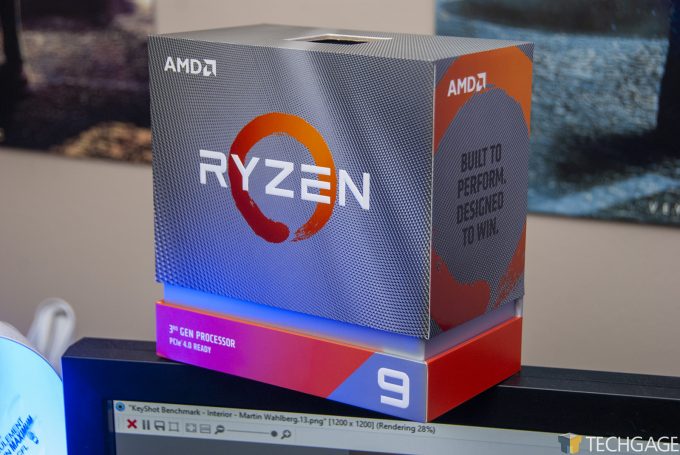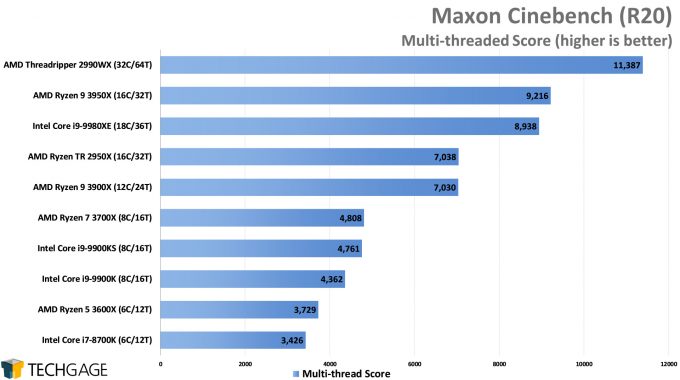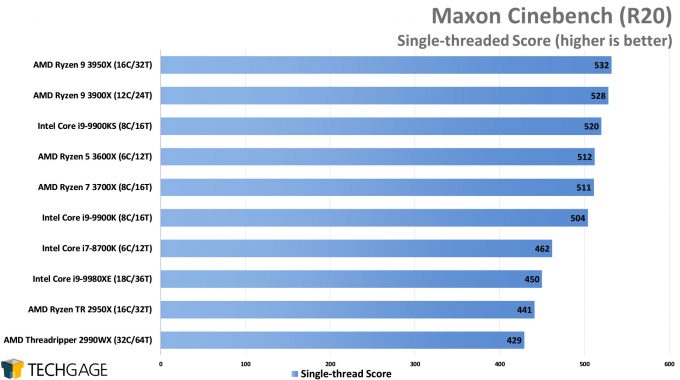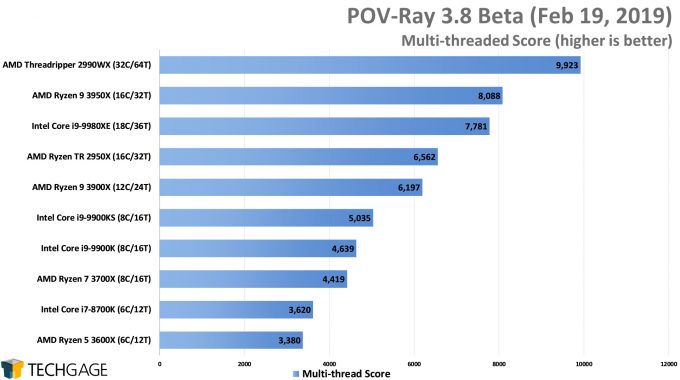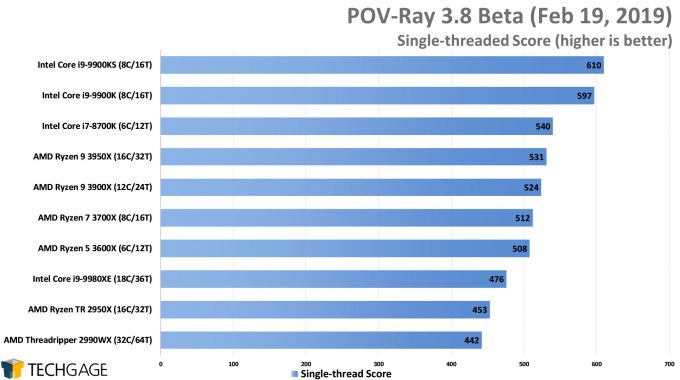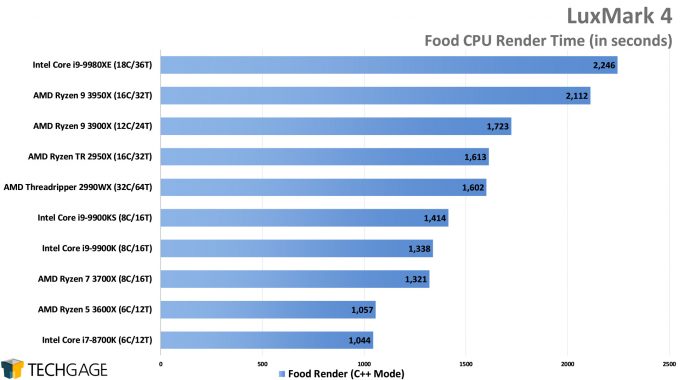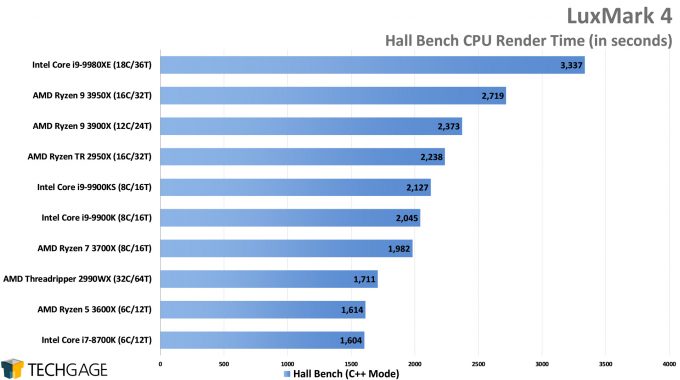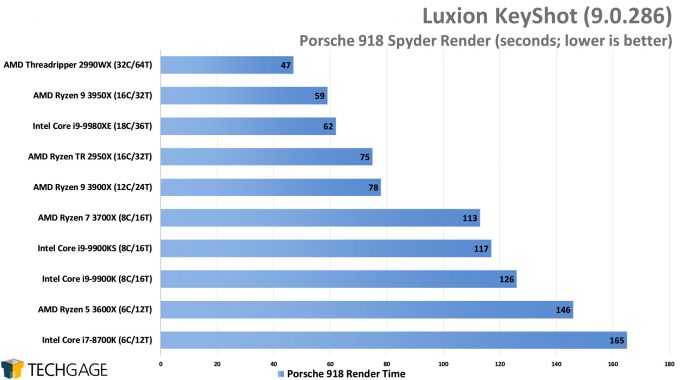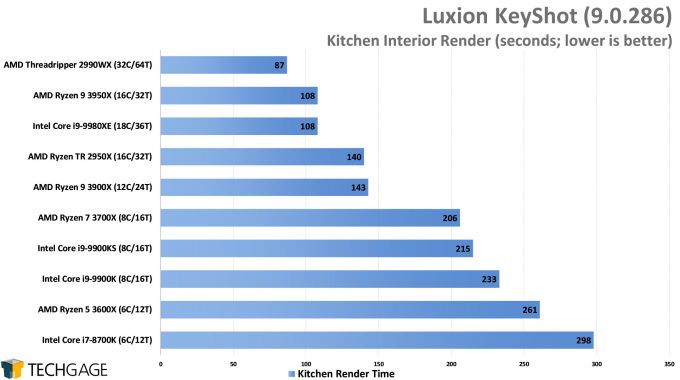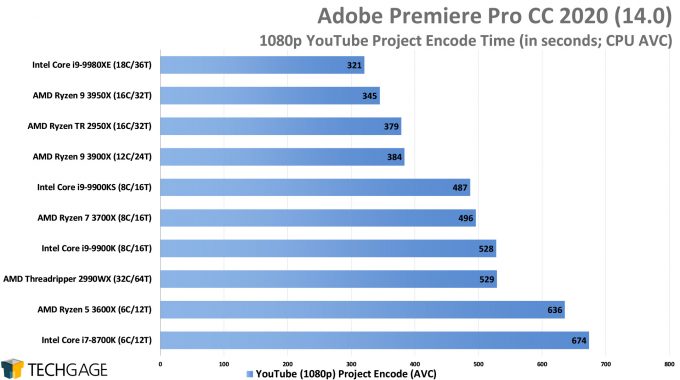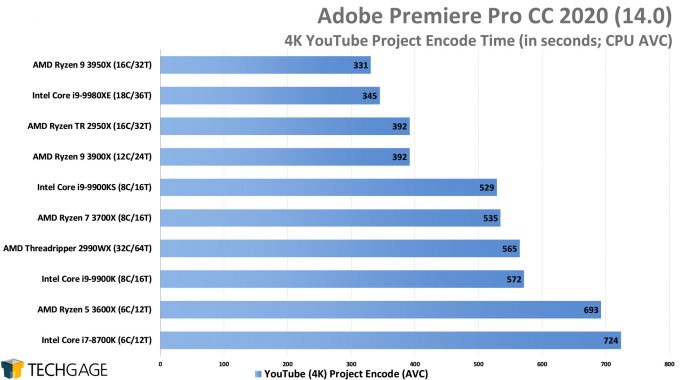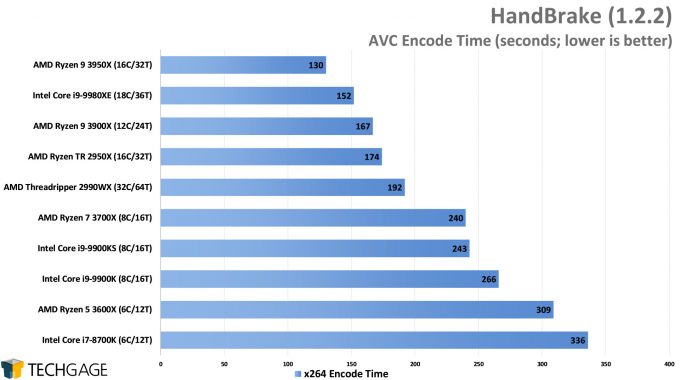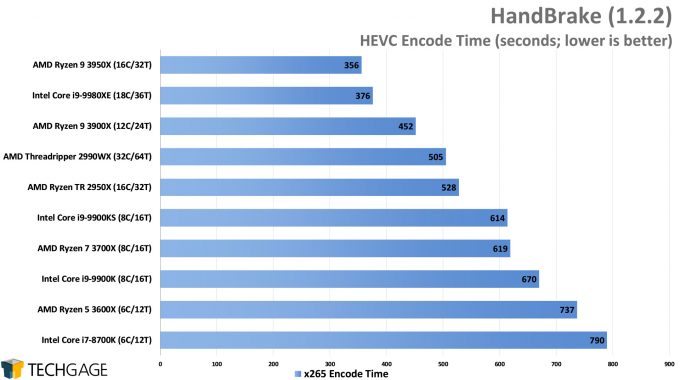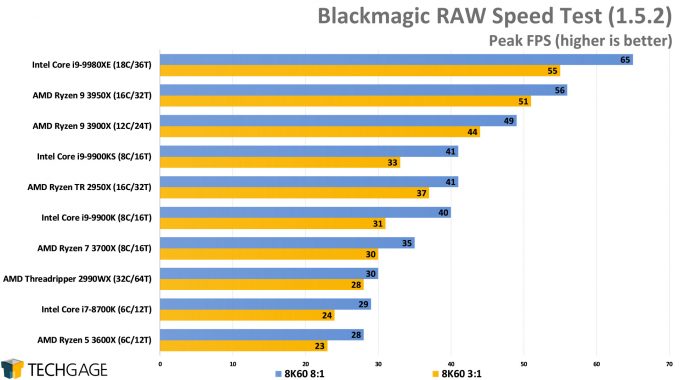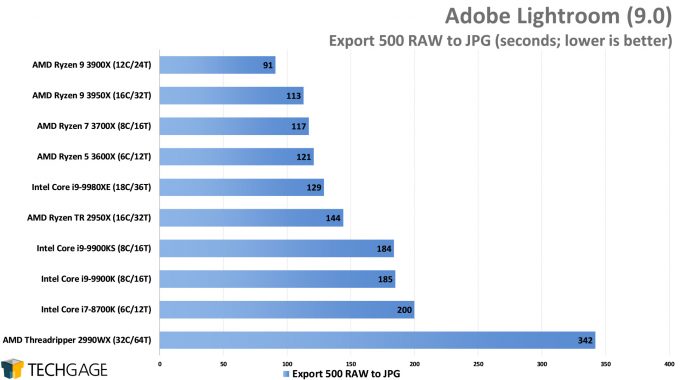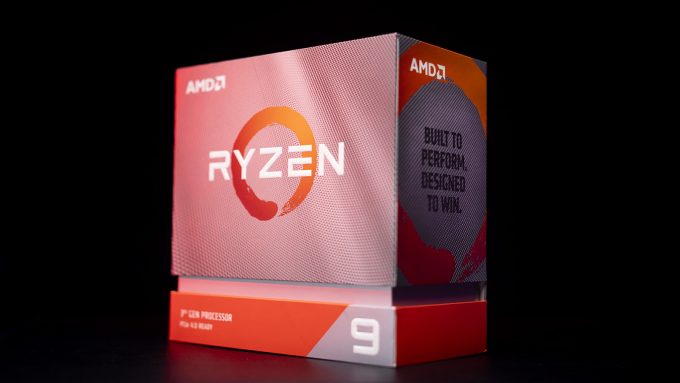- Qualcomm Launches Snapdragon 4 Gen 2 Mobile Platform
- AMD Launches Ryzen PRO 7000 Series Mobile & Desktop Platform
- Intel Launches Sleek Single-Slot Arc Pro A60 Workstation Graphics Card
- NVIDIA Announces Latest Ada Lovelace Additions: GeForce RTX 4060 Ti & RTX 4060
- Maxon Redshift With AMD Radeon GPU Rendering Support Now Available
A Quick Look At AMD’s 16-core Ryzen 9 3950X Processor

We’re a little late on our full-blown look at AMD’s new sixteen core Ryzen 9 3950X, thanks in part to a recent suite overhaul that’s proving to take quite a while to run on each chip. We’re going to kick our coverage off with a quicker look at both rendering and encoding performance, so far comparing it to the 3700X, 3900X, 2950X, and also Intel’s Core i9-9900K and 9900KS.
Results for AMD’s Ryzen 3600X and 2990WX, as well as Intel’s 8700K and 9980XE, were added after publishing.
Ahead of its November 25 release, AMD is today lifting the embargo on its highly anticipated sixteen core Ryzen 9 3950X, allowing us to spill the beans on its performance. We’re running a bit behind here, so we’re greeting this launch with a much simpler look than usual, just to cover some basics, and will follow-up with much fuller performance in the days ahead.
We significantly updated both our Windows and Linux test suites leading up to this launch. On the Windows side of the fence, we’ve added Adobe Lightroom, LuxMark, Blackmagic RAW Speed Test, RealityCapture, and Total War: Three Kingdoms. Unfortunately, RealityCapture hasn’t proven as reliable to benchmark as we’d like, so we’ll have to revisit that one in particular soon.
In addition to the new tests, many of our preexisting tests have been given upgrades and / or had their software updated. Some of the software upgrades include Adobe Dimension 3.0 and Premiere Pro 2020, Luxion KeyShot 9, SiSoftware Sandra 2020, Maxon Cinema 4D R21, and the various renderers we use (eg: V-Ray, Arnold.)
Because we’d rather save energy for our full review, we’re going to tackle only a fraction of our overall test suite here. Due to time, we only have six CPUs tested so far with the new suite, but we will be rapidly adding more, and plan to update this article with a couple of additional models tomorrow, and follow-up with the full review on Saturday (or sooner if luck is on our side) (Saturday addendum: Full testing has taken a lot longer than expected, so a look at Linux performance is expected first, since it’ll be quicker to complete).
For those interested in our testing methodologies, you can refer to the relevant page from our previous review. There are a couple of things worth pointing out before we get into performance, such as the big elephant in the room: Windows 10 1909. This is a long-awaited update that brings some polish to how “best cores” are handled, something that complements recent AGESA and chipset driver updates that improve thread-handling.
Windows 10 1909 isn’t a typical release, because it’s really meant to act as an in-between to tide us over until the bigger spring update. All of our testing was done in Windows 10 1903, but we sanity checked with 1909, and overall – there were no differences. The “best cores” thing is likely to be seen in specific benchmarking, and certainly won’t change the performance picture overall.
All of that aside, all of our test rigs have their latest EFI equipped, as well as the latest respective chipset driver installed. We’re sticking to CPU-only tests here; GPU-specific ones (such as gaming) are coming (one GPU is hard to share among multiple test beds!). So with all of that said, let’s jump into our quick results:
Rendering
AMD’s been promoting Cinebench since the original Zen launch. At that time, AMD performance looked strong, but it’s only become better over time, as if AMD specifically targeted this workload as one it wanted to bolster. For our full review, we’ll have C4D R21 results as well, although we can say at this point that the scaling is pretty much identical (so far) to R20.
To give an idea of how much Cinebench performance has improved over Zen’s life, take a look at the scores between the 12-core 3900X and 16-core last-gen 2950X. Despite having four fewer cores, the 3900X matches the last-gen Threadripper. It’s no surprise, then, that the 16-core Zen 2 chip wipes the floor with it. On the single-threaded front, AMD’s strengths put the 3950X on the top.
Here’s POV-Ray with a second opinion:
Whereas Cinebench has been performing amazingly on Zen hardware, POV-Ray tends to run better on Intel, but if the blue camp’s core count doesn’t match, it’s going to spell trouble. Core-for-core, Intel wins its match-ups against Zen 2, with the single-threaded performance being on another level. It’s always impossible to judge single-threaded performance on a single test, since another test might give a completely different opinion. Some might wonder why we even include POV-Ray, but these additional opinions can be helpful.
LuxMark 4 was released in alpha not too long ago, and while we’ve run the benchmark for a while in our workstation graphics card reviews, it’s a new entry to our CPU reviews. Let’s see how it fares:
We’re seeing similar performance in LuxMark as we did with POV-Ray, where Intel seems to have an inherent strength, but core counts matter more than anything. The gains here for the 3950X are not quite as stark as they were for POV-Ray, but they’re still notable enough. These charts highlight another example of the kind of advantages Zen has gained over time. The new 16-core easily demolishes the old 16-core.
We’ll wrap up our quick look at rendering with the new KeyShot 9. We’re going to be taking a deeper look at KS9 in the near future, and likely will change-up our projects a little bit, but for now, we’re sticking to the same projects we’ve been using since KS7. Yet again, the 3950X manages to shine, especially when compared to the last-gen 2950X. We’re used to incremental upgrades from one gen to the gen, but these are major jumps so far.
Encoding
Our Premiere Pro test suite has been upgraded since the last time we published a review around it, but a lot of the performance data will wait for a dedicated content piece coming in the near future (for encode; we’ll get to playback when we can create tests for it.)
The 3950X continues it dominance here, but clearly, we’ve done a disservice by having so many higher-tier models missing, because the new 16-core could shine even more. We actually don’t even have any Intel chip that sits between the 9900KS and 9980XE unless we we’re to use the older 10-core 7900X, so there’s only so much gap-filling we could do at the top-end regardless.
We’re seeing another example of the new 12-core matching the last-gen 16-core, so naturally, the new 16-core simply cleans house. Interestingly, while the 9900K and 9900KS don’t normally show that great of a difference in tests, the KS actually does manage to pull ahead a fair distance here, in both tests.
With HandBrake, almost nothing changes in the scaling from Premiere Pro, which is interesting since the Adobe tests are full YouTube projects, and the HandBrake tests are just simple transcodes. Either way, the scaling is similar, with the 3950X sitting on the top. We remember some bad scaling that Zen endured in HandBrake with the Threadripper 2 launch, so things have certainly improved since then.
We have not tested with DaVinci Resolve enough to understand its true behavior, but according to its standalone RAW Speed Test, Blackmagic says that the 3950X is the CPU to beat – at least in this particular lineup. If we had our entire desired collection tested here, the 3950X would still sit near the very top, based on our earlier more in-depth look at the benchmark.
We will say that the GPU will matter a lot in Resolve as well, but we’re still not entirely sure how much more important it is than the CPU. If we base it on the simple BRAW results we’re given, the GPU is always going to be the better accelerator for video playback, but that doesn’t mean you should skimp on your CPU, since the CPU will usually be relied-upon more often during encoding.
We’ll finish up our quick look at the 3950X with just one more test, Adobe Lightroom:
Ahhhhh, we just couldn’t get through this quick look without a performance anomaly, could we? This scaling is something we can’t explain quite yet, but our retests have proven that there’s no mistaking the scaling. Somehow, the 16-core 3950X is performing worse than the 3900X, despite much better scaling being seen across a fuller stack with our last big test.
We’re not sure why there is odd scaling here, but it’s fortunately the only case we have of it across our entire test suite so far (that includes Linux). The funny thing is this: even though the 3950X performs worse than the 3900X in this test, it’s still faster than every thing else in the lineup. Clearly, Zen 2’s cache-richness helps a lot here, allowing it to negate a weird performance issue to still place extremely well.
(Quick) Final Thoughts
At this point, we’ve already completely benchmarked the 3950X across our entire test suite – and that includes Linux – but we need more models to finish testing before we dump the rest of the results on you. As mentioned earlier, we plan to augment this article in the next day with additional models, and then follow-up soon after with the full review. Ideally, we’d like to get the 6-core Intel Core i7-8700K and AMD Ryzen 5 3600X added, as well as a couple more Threadrippers.
What we can say for now is that the chip behaves almost entirely as we expected. Adobe Lightroom is the absolutely only anomaly we’ve encountered so far, and to AMD’s benefit, the odd fact that the 3900X places ahead of it doesn’t even hurt its overall standing that much, because the performance delivered from the 3950X is still better than the entire rest of the stack we’ve tested. That said, we were stoked after seeing what the 3900X could do, so it was a little deflating to see worse performance on the 3950X.
For its price point of $749, AMD seems to be pricing this chip quite well. That said, the biggest caveat to be aware of with such a big chip like this is that the typical 4-channel memory controller we’ve seen with the other 16+ core models is not present here. That means if you have heavier bandwidth needs, you’ll want to consider an enthusiast platform, like Threadripper or Core X. Fortunately, new chips from both series are coming this month.
We’re living in interesting times right now. Intel’s 18-core is going to be $1,000, and meanwhile, AMD won’t have anything to fill the gap between the $749 (16-core 3950X) and $1400 (24-core 3960X), which means Intel will actually be filling the in-between with the 10980XE. That said, AMD has told us that it plans to continue selling certain Threadripper second-gen SKUs to help fill the void, which means we have all the more reason to make sure the outgoing 24- and 32-cores get tested.
At this point, we’re seriously impressed with AMD’s new 16-core chip. We’ll save our final final thoughts for the actual review, after we can compile the rest of our data. Things are even looking great on the gaming side, so we’re anxious to being able to publish the rest of our data. Stay tuned!
Support our efforts! With ad revenue at an all-time low for written websites, we're relying more than ever on reader support to help us continue putting so much effort into this type of content. You can support us by becoming a Patron, or by using our Amazon shopping affiliate links listed through our articles. Thanks for your support!




